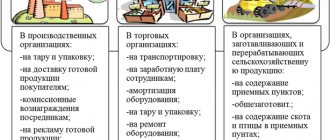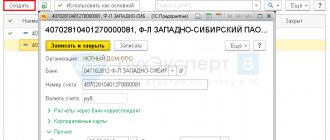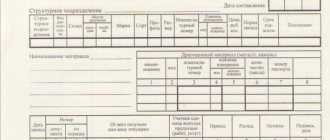Payroll
Settlements with company personnel for wages are accumulated in account 70. This account is passive, since all calculated amounts of employee earnings are taken into account on a loan. This is done on the last date of the month. And on the 1st day of each next month, the credit balance is reported to employees.
Account analytics is carried out for each employee using personal accounts (cards) in the T-54(a) form.
You will find the current form and the procedure for filling it out in the article “Unified form No. T-54a (personal account (SVT)).”
The amount of accrued salary is posted to the appropriate expense accounts depending on the department in which the employee is registered. Postings in each specific case can be as follows: Dt 20 (23, 26, 44) Kt 70.
If an employee was engaged in the construction or repair of fixed assets, then his earnings should be reflected in the entry: Dt 08 (07) Kt 70.
When calculating sick leave, the calculated amount should be included in debit 69, since it is not an expense of the enterprise and is reimbursed from the budget using the social insurance fund: Dt 69 Kt 70.
Important! The employer pays for the first 3 days of illness of the employee.
What are the subaccounts?
Each employee of the company creates his own sub-account, which will account for all accruals, payments and deductions for the entire period of his work in the organization. For ease of work, they are combined by department and divided into the following groups:
- payments to employees included in the company's staff;
- payments to employees with whom a contract has been concluded;
- payments to employees working part-time;
- payments to employees with a confirmed disability group.
Each organization itself has the right to create and approve the analytics it needs, but taking into account the requirements of Order of the Ministry of Finance No. 94n dated October 31, 2000.
The following subaccounts are most common at enterprises of different levels:
- 70.1 - used for payroll;
- 70.2 - serves to reflect deposited amounts;
- 70.3 - salary debts are reflected;
- 70.4 - shows the amounts to be issued;
- 70.5 - amounts transferred to deposits are entered;
- 70.6 - reflects the rounding amounts used when calculating wages.
Postings for deductions from wages: Dt 70 Kt 76 (73, 68)
- The responsibility of the employer, who is an intermediary (tax agent) between the Federal Tax Service and the recipient of income (employee), is to calculate and withhold personal income tax. In this case, the entry is made: Dt 70 Kt 68.
For more information about the nuances of calculating personal income tax, see the article “Calculation of personal income tax (personal income tax): procedure and formula.”
- If a loan agreement has been entered into between the employee and the company, monthly interest and principal amounts may be deducted from his paycheck. The basis is a written statement from the employee. The accounting entry in this case will be as follows: Debit 70 Credit 73.
- Deductions for compensation for shortages of goods and materials or damage caused are reflected similarly: Dt 70 Kt 73.
- In addition, the employer is obliged to make deductions from the salary accrued to the employee according to executive documents. These may be court orders or bailiff orders, notarized agreements on the withholding of alimony, etc. Such transactions are reflected by the posting: Dt 70 Kt 76.
Postings for salary payments Dt 70 Kt 50 (51)
According to the instructions of the Central Bank of the Russian Federation “On the procedure for conducting cash transactions...” dated March 11, 2014 No. 3210-U, the cashier must pay wages according to payrolls. In this case, an entry is made: Dt 70 Kt 50.
3 days are given for payment according to the statement. If for some reason the employee does not show up within the specified period, the cashier writes in the “Signature” column indicating the following entry: Dt 70 Kt 76. The employee can receive the deposited salary within 3 years.
Payments can also be made to employee salary cards. The wiring in this case will be as follows: Dt 70 Kt 51.
Count 73: general information
Account 73 belongs to the category of active-passive accounting accounts. Its balance can be formed in both the debit and credit parts.
Paying wages or accounting for imprest are not the only transactions in which employees receive or return funds from the company. There are a number of other circumstances in which count 73 can be used:
- employees receive a loan from the company;
- payment is made for damage caused by the employee;
- the company pays for the operation of the employee’s property, for example, a car;
- a fee was charged for the employee's telephone calls, which is subject to reimbursement by the employer.
The positive balance goes to the debit of the account and is identified as the employee’s debt to the company. The credit part indicates the negative balance, which is the debt of the enterprise. Individual analytical records are maintained for each employee of the company.
Depending on the specific situation, additional subaccounts may be opened to account 73. This approach allows you to isolate objects separately and make all the necessary calculations for each of them. For example, subaccount 73.01 - loan payments or subaccount 73.02 - compensation for damage.
Legislative basis
When making payments to employees, the enterprise's accounting department uses account 73 in certain cases listed above. All operations must be carried out in accordance with regulations:
- Loans are issued on the basis of a concluded contract in accordance with Art. 808 of the Civil Code of the Russian Federation.
- In accordance with Art. 212 of the Tax Code of the Russian Federation determines the tax base, calculates and pays the income tax of individuals within the limits of the organization’s responsibilities as a tax agent.
- The provision of financial assistance occurs upon the individual application of the employee and upon the decision of management. This type of payment does not fall into the category of production and incentive payments according to Art. 144 Labor Code of the Russian Federation. When calculating mandatory payments, the total amount of financial assistance is not included in the tax base for income tax in accordance with clause 23 of Art. 270 Tax Code of the Russian Federation.
- For remunerations in the amount of no more than 4,000 rubles, personal income tax benefits are provided. This action is regulated by clause 28 of Art. 217 Tax Code of the Russian Federation.
Typical accounting entries for account 73
In order to fully keep records, an accountant must know about the standard entries of account 73 and be able to use them in practice. We are talking about the following correspondence:
| Debit correspondence | Loan correspondence | Operation |
| 20, 29, 23, 28 | Damage was caused to the main or additional production line, the defect was attributed to the culprits | |
| 50, 51, 52, 57, 62 | Ruble or foreign currency loans were issued to employees: from a current or card account, from the company’s cash desk | |
| 50, 52 | Amount paid for renting employee property | |
| 68, 69, 76 | Tax and insurance amounts accrued and paid | |
| The employee's debt is transferred when transferred from a branch to the main office | ||
| The employee is given shares in the company | ||
| Interest is charged on loans provided | ||
| 94, 98.4 | Write-off of damage or determination of the difference in book value | |
| Charging fees for the use of an employee’s personal property | ||
| Receipt of goods on account of debt | ||
| 50, 51, 52 | Crediting payment for damages from an employee | |
| 70, 76 | Deduction from the employee’s earnings or compensation under his insurance agreement | |
| Writing off a debt that is impossible to collect | ||
| Claimed amounts for shortages | ||
| Debt write-off due to special circumstances. For example, the debtor died |
When it is necessary to determine the amount of damage caused by a company employee, only direct damage is taken into account. Lost income is not taken into account. Reimbursement by the employee may be made in installments.
Example of invoice registration 73
The company employs more than 50 employees. To help people settle down, they are given loans in the amount of 500,000 rubles at 10% per annum. First, the technician Ivanov received the loan, and then the builder Petrov. At the same time, an inventory was taken and it turned out that Petrov had a shortage of 50,000 rubles. The employee paid off the debt in cash. By the end of the reporting period, the accountant generated the following entries:
- Dt. 73.01 – Kt. 50 – 1,000,000 rubles
Loans issued from the cash desk of the enterprise to Petrov and Ivanov for the arrangement.
- Dt. 73.01 – Kt.93.01 – 100,000 rubles
Interest accrued on the loan in the amount of 10%.
- Dt. 73.02 – Kt. 20 – 50,000 rubles
Petrov has identified a shortage in his main production.
- Dt. 50 – Kt. 73.02 – 50,000 rubles
The discovered shortage was covered by Petrov through the cash register.
- Dt. 73.02– Kt. 94 – 50,000 rubles
Petrov's shortage has been written off.
Summary: using account 73 with the opening of additional sub-accounts allows you to maintain analytical accounting for several objects at once. The example concerns loans issued to employees of an enterprise and a deficiency discovered in one of them.
Account 73 “Settlements with personnel for other operations”
This material, which continues the series of publications devoted to the new chart of accounts, analyzes account 73 “Settlements with personnel for other operations” of the new chart of accounts. This commentary was prepared by Y.V. Sokolov, Doctor of Economics, Deputy. Chairman of the Interdepartmental Commission on Reforming Accounting and Reporting, member of the Methodological Council on Accounting under the Ministry of Finance of Russia, first President of the Institute of Professional Accountants of Russia, V.V. Patrov, professor of St. Petersburg State University and N.N. Karzaeva, Ph.D., deputy. Director of the audit service of Balt-Audit-Expert LLC.
Account 73 “Settlements with personnel for other operations” is intended to summarize information on all types of settlements with employees of the organization, except for settlements for wages and settlements with accountable persons.
Sub-accounts can be opened to account 73 “Settlements with personnel for other operations”:
73-1 “Calculations for loans granted”, 73-2 “Calculations for compensation for material damage”, etc.
Subaccount 73-1 “Settlements for loans provided” reflects settlements with employees of the organization for loans provided to them (for example, for individual and cooperative housing construction, the acquisition or construction of garden houses and the improvement of garden plots, starting a household, etc.).
The debit of account 73 “Settlements with personnel for other operations” reflects the amount of the loan provided to an employee of the organization in correspondence with account 50 “Cash” or 51 “Cash accounts”.
For the amount of payments received from the borrower employee, account 73 “Settlements with personnel for other operations” is credited in correspondence with accounts 50 “Cash”, 51 “Settlement accounts”, 70 “Settlements with personnel for wages” (depending on the accepted payment procedure).
Subaccount 73-2 “Calculations for compensation for material damage” takes into account calculations for compensation for material damage caused by an employee of the organization as a result of shortages and thefts of monetary and commodity-material assets, defects, as well as compensation for other types of damage.
In the debit of account 73 “Settlements with personnel for other operations,” the amounts to be recovered from the guilty parties are included in the credit of accounts 94 “Shortages and losses from damage to valuables” and 98 “Deferred income” (for missing inventory items), 28 “Defects in production” (for losses from defective products), etc.
In the credit of account 73 “Settlements with personnel for other operations”, entries are made in correspondence with the accounts: cash accounting - for the amounts of payments made; 70 “Settlements with personnel for wages” - for the amount of deductions from wages; 94 “Shortages and losses from damage to valuables” - for the amount of written off shortfalls in case of refusal to recover due to the unfoundedness of the claim.
Analytical accounting for account 73 “Settlements with personnel for other operations” is maintained for each employee of the organization.
Any organization may have settlements with its employees. First of all, payroll calculations are taken into account in account 70 “Settlements with personnel for wages”) and for accountable amounts (accounted for in account 71 “Settlements with accountable persons”). The compiler of the chart of accounts assumes that all other types of settlements should be accounted for in separate subaccounts of account 73 “Settlements with personnel for other transactions.” Here, first of all, subaccount 73.1 “Settlements on loans provided” is highlighted. They arise due to the fact that the administration of the organization sometimes issues him a loan, usually interest-free, (for the purchase of an apartment, a summer house, a plot of land and some other needs). If an employee receives a loan, then account 73.1 “Settlements for loans provided” is debited and cash accounts are credited. If interest is expected to be received, then an entry is made for their accrual:
Debit 73.1 “Settlements on loans provided” Credit 91.2 “Other income”
Further, for issued loans, two possibilities arise:
- or the loan with interest will be repaid;
- or the loan with interest will not be fully and/or partially repaid.
In the first case, the entries are obvious; they, as a rule, will depend on how the debt will be repaid:
- if directly in cash, then Debit 50 “Cash”;
- if through a bank - Debit 51 “Current accounts”;
- if from wages - Debit 70 “Settlements with personnel for wages”.
In all cases, account 73.1 “Settlements on loans provided” is credited.
Subaccount 73.2 “Settlements for compensation for material damage” takes into account settlements with employees of the enterprise for compensation for material damage caused by an employee of the organization as a result of shortages and thefts of monetary and inventory items, defects, as well as compensation for other types of damage.
Collection of amounts in compensation for commodity losses established based on the results of the inventory from financially responsible persons must be carried out in accordance with the Labor Code of the Russian Federation.
Financial liability for damage caused to the organization during the performance of labor duties is assigned to the employee, provided that the damage was caused through his fault. This liability is usually limited to the employee's average monthly earnings and should not exceed the full amount of damage caused, except as otherwise provided by law. Such cases include full financial responsibility, which the employee bears in accordance with the agreement on full financial responsibility concluded with the administration of the enterprise. Cases of full financial liability are established by Article 243 of the Labor Code of the Russian Federation.
When determining the amount of damage, only direct actual damage is taken into account; income not received is not taken into account.
Article 246 of the Labor Code of the Russian Federation states: “The amount of damage caused to the employer in the event of loss and damage to property is determined by actual losses, calculated on the basis of market prices prevailing in the area on the day the damage was caused, but not lower than the value of the property according to accounting data, taking into account the degree of wear and tear of this property.”
The procedure for collecting damages is determined by Article 248 of the Labor Code of the Russian Federation. Recovery of an amount of damage not exceeding the average monthly salary is carried out by order of the employer. The order can be made no later than one month from the date the amount of damage is established. If the monthly period has expired or the employee does not agree to voluntarily compensate for the damage caused, and the amount exceeds the employee’s average monthly earnings, then recovery is carried out in court.
The employee responsible for the damage may voluntarily compensate for it in full or in part. Compensation for damage by installments is allowed (under the written obligation of the employee).
For each payment of wages, the total amount of all deductions cannot exceed 20%, and in cases specifically provided for by law - 50% of the wages due to the employee (Article 138 of the Labor Code of the Russian Federation). The amount of deductions from wages when serving correctional labor cannot exceed, in accordance with Article 138 of the Labor Code of the Russian Federation, 70%.
The employee’s debt for compensation for damage is reflected in account 73 “Settlements with personnel for other operations” subaccount 2 “Calculations for compensation of material damage”. The balance sheet estimate of lost material assets, subject to compensation by the financially responsible person, is written off from account 94 “Shortages and losses from damage to valuables” to account 73.2 “Settlements with personnel for other operations” “Settlements for compensation of material damage”:
Debit 73 “Settlements with personnel for other operations” subaccount 2 “Calculations for compensation of material damage” Credit 94 “Shortages and losses from damage to valuables”
If the cost of missing goods is recovered from the perpetrators at prices exceeding their book value, then the difference between the cost of the missing valuables credited to account 73 “Settlements with personnel for other operations” subaccount 2 “Calculations for compensation of material damage” and their value reflected on account 94 “Shortages and losses from damage to valuables”, is credited to account 98 “Deferred income” subaccount 4 “The difference between the amount to be recovered from the guilty parties and the book value for shortfalls of valuables”:
Debit 73 “Settlements with personnel for other operations” subaccount 2 “Calculations for compensation of material damage” Credit 98 “Deferred income” subaccount 4 “The difference between the amount to be recovered from the guilty parties and the book value for shortages of valuables”
As the amount due is collected from the guilty person, the following is reflected in the following entries:
Debit 50 “Cash” Credit 73 “Settlements with personnel for other operations”, subaccount 2 “Settlements for compensation of material damage”
or when deducting amounts from wages to pay off debt:
Debit 70 “Settlements with personnel for wages” Credit 73 “Settlements with personnel for other operations” subaccount 2 “Settlements for compensation of material damage”
The above difference is written off from account 98 “Deferred income” subaccount 4 “The difference between the amount to be recovered from the guilty parties and the book value for shortages of valuables” to the account of financial results:
Debit 98 “Deferred income” subaccount 4 “The difference between the amount to be recovered from the guilty parties and the book value for shortages of valuables” Credit 91 “Other income and expenses” subaccount 1 “Other income”
Shortages of valuables identified in the current year, but relating to previous periods, recognized by financially responsible persons or for which there are decisions of judicial authorities to recover from the guilty persons, are reflected in the debit of account 94 “Shortages and losses from damage to valuables” and the credit of account 98 “Income future periods."
At the same time, account 73 “Settlements with personnel for other operations” (sub-account “Settlements for compensation of material damage”) is debited with these amounts and account 94 “Shortages and losses from damage to valuables” is credited. As the debt is repaid, account 91 “Other income and expenses” subaccount 1 “Other income” is credited and account 98 “Deferred income” is debited.
Example
Based on the results of the inventory of goods, a shortage of goods in the amount of 180 rubles was established. at sales prices. The trade margin is 20% of the purchase price of the goods. According to the calculation of commodity losses as a result of natural loss, a shortage was established within the limits of natural loss norms in the amount of 42 rubles. The market price (with a markup) of the goods on the day of inventory was 170 rubles.
Let's consider two options for reflecting transactions to write off commodity losses in the accounting accounts:
Option 1. Operational accounting is kept at purchase prices (Table 1). Option 2. Operational accounting is kept at sales prices (Table 2)
Table 1
Accounting entries to reflect inventory results when maintaining records at purchase prices
| No. | Contents of economic and financial transaction | Debit | Credit | Sum |
| Product shortage reported | 180 : 120 * 100 = 150 | |||
| The shortage of goods was written off as a result of natural loss | 42 : 120 * 100 = 35 | |||
| The shortage of goods caused by the fault of the financially responsible person has been written off | 138 : 120 * 100 = 115 | |||
| The difference between the amount collected and the cost of goods at discount prices is reflected in the accounting | 170 — 115 = 55 | |||
| Repayment of debt by a financially responsible person by depositing money into the cash register | ||||
| Deferred income for reimbursable losses was written off by the financially responsible person |
table 2
Accounting entries to reflect inventory results when maintaining records at sales prices
| No. | Contents of economic and financial transaction | Debit | Credit | Sum |
| Product shortage reported | 180 : 120 * 100 = 150 | |||
| Trade markup on goods written off | 180 : 120 * 20 = 30 | |||
| The shortage of goods was written off as a result of natural loss | 42 : 120 * 100 = 35 | |||
| The shortage of goods caused by the fault of the financially responsible person has been written off | 138 : 120 * 100 = 115 | |||
| The difference between the amount collected and the cost of goods at discount prices is reflected in the accounting | 170 — 115 = 55 | |||
| Repayment of debt by a financially responsible person by depositing money into the cash register | ||||
| Deferred income for reimbursable losses was written off by the financially responsible person |
Analytical accounting of calculations is carried out separately for each employee.
Accounting account 73 is an active-passive account “Settlements with personnel for other operations.” Let's consider what transactions account 73 is used to account for, what accounts account 73 corresponds with, as well as typical entries in account 73 using the example of transactions of issuing a loan to an employee, compensation for the use of personal vehicles for business purposes and writing off shortages.
Account 73 in accounting
In addition to remuneration or accountable amounts, other situations may arise in an organization regarding the accounting of settlements with personnel, for example, accounting for shortages or the use of personal property. For these purposes, account 73 “Settlements with personnel for other operations” is used.
Let's look at other situations:
- Providing loans;
- Compensation for material damage;
- Payment for the use of personal property (for example, a car);
- Reimbursement for telephone calls;
- Other calculations.
For each situation, you can select a separate subaccount:
Characteristics of account 73 Settlements with personnel for other transactions:
- It is an active-passive account. The debit balance characterizes the debt of the employee, and the credit balance - of the organization;
- Analytical accounting is carried out in the context of enterprise employees.
***
Account 73 in accounting is an accounting tool for displaying transactions for mutual settlements with enterprise personnel. Account 73 is active-passive: it can have both a debit and a credit balance. Three sub-accounts can be opened to account 73 in order to provide deeper detail of the transactions performed for each employee of the enterprise: settlements for loans, settlements for damages and other settlements with employees. The main entries in account 73 reflect the provision of loans (other funds) to employees or their repayment of debt. Settlements with personnel for wages on account 73 are not taken into account. The execution of transactions on this account is regulated by the Tax, Civil and Labor Codes of the Russian Federation and other regulatory documents.
Correspondence of account 73 with other accounts
Table 1. By debit of account 73:
| Dt | CT | Wiring Description |
| 73.02 | 20, 29,23 | Damage caused to the main, servicing or auxiliary production is written off to the perpetrators |
| 73.02 | 28 | The marriage is blamed on the guilty parties |
| 73.01 | 50, 51, 52, 57, 62 | A loan was issued from the cash desk, from a current or foreign currency account, by transferring transfers or by endorsing buyer bills |
| 73.03 | 50, 52 | Payment of rental of personal property or reimbursement of amounts for the use of personal property through a cash register or bank account |
| 73.03 | 68 | Withholding personal income tax from other transactions |
| 73.03 | 69 | Debt on insurance premiums for other operations |
| 73.03 | 76 | Insurance payments for personal insurance are reflected |
| 73 | 79 | Transfer of debt upon transfer from a separate division |
| 73.03 | 81 | Issue of own shares |
| 73.01 | 91.01 | Interest on loans issued |
| 73.02 | 94 | The amounts of shortages and damages within the book value were written off |
| 73.02 | 98.4 | Difference between recoverable and book value, shortfalls for previous years |
| 73.02 | 99 | Amounts of damage from emergency events (fire, accident) are written off to the perpetrators |
Table 2. For the credit of account 73:
| Dt | CT | Wiring Description |
| 20 | 73.03 | Accrual of rental of personal property or reimbursable amounts for the use of personal property through a cash register or checking account |
| 41 | 73 | Receipt of goods through payment of debt |
| 50, 51, 52 | 73 | Receipt of payment from employees (loan payment, compensation for shortages, losses from defects) |
| 70 | 73 | Deduction of employee debt from wages |
| 76 | 73 | Amounts of compensation under the employee's insurance contract |
| 91.02 | 73 | Write-off of unreceivable debt |
| 94 | 73 | The claim for shortages is not justified, write-off of debt for shortages |
| 99 | 73 | Write-off of debt in connection with emergency situations in which an employee died |
Accounting for compensation for the use of employee personal property
An agreement was concluded between Svetofor JSC and sales department employee K.D. Konovalov, under which Konovalov transfers his car to Svetofor for use for production purposes. The agreement provides that:
- the car is used by Konovalov to deliver products from Svetofor JSC to customers;
- monthly payment for using a car is 3,840 rubles;
- JSC "Svetofor" compensates Konovalov for the cost of fuel and lubricants spent when using the car.
At the end of March 2015, Konovalov consumed fuel in the amount of 4,125 rubles.
Transactions to pay compensation to Konovalov are reflected in the accounting records with the following entries:
| Dt | CT | Description | Sum | Document |
| 44 | 73.01 | The accrual of funds as compensation for the use of Konovalov’s personal car is reflected | RUR 3,840 | Contract for services |
| 73.01 | 51 | Funds were transferred to Konovalov’s bank card to pay compensation for the use of a personal car | RUR 3,840 | Payment order |
| 44 | 73.01 | Reflection of the accrual of the amount that is compensated to Konovalov for spent fuel and lubricants | 4.125 rub. | Waybill |
| 73.01 | 51 | Funds were transferred to Konovalov’s bank card to pay compensation for spent fuel and lubricants | 4.125 rub. | Payment order |
| 99 | 68 Income tax | The amount of permanent tax liability is reflected (RUB 4,125 * 20%) | 825 rub. | Accounting certificate-calculation |
Examples of using account 73 in accounting
Example 1. Accounting for a loan to an employee in account 73
On December 1, employee Petrova A.S. A loan in the amount of 70,000 rubles was issued. for a period of 1 year at 6%. The loan is repaid with salary deductions in the amount of RUB 6,000. monthly. The Central Bank refinancing rate was 10%.
Let's make the calculation:
- Interest - 70,000 rubles. * 6% / 366 days a year * 31 calendar days = RUB 355.74;
- Material benefit – 70,000 rubles. * (2/3 * 10% - 6%) / 366 days a year * 31 calendar days = 39.53 rubles;
- Personal income tax – 39.53 * 35% = 13.84 rubles.
The solution to the example with postings to account 73 in the table:
| date | Account Dt | Kt account | Amount, rub. | Wiring Description |
| December 01 | 73.01 | 51 | 70 000 | The loan amount was issued to the current account |
| December 03 | 73.01 | 91.01 | 355,74 | Interest accrued |
| December 10 | 51 | 73.01 | 355,74 | The employee paid the interest |
| 31th of December | 70 | 68 | 13,84 | Personal income tax accrued on material benefits |
Example 2. Accounting for compensation for the use of a personal car in account 73
Employee Petrov E.P. by agreement with the employer, uses his personal car for business trips. The amount of monthly compensation is set at 2,000 rubles. (within the normal range - 1,200 rubles and 800 rubles in excess of the norm).
Solution to the example with postings to account 73:
| date | Account Dt | Kt account | Amount, rub. | Wiring Description |
| Accounting | ||||
| December 01 | 44 | 73.03 | 2 000 | Compensation awarded for the use of a personal car |
| 31th of December | 73.03 | 50 | 2 000 | Compensation paid |
| If PBU 18/02 is applied | ||||
| WELL | 44 | 73.03 | 1 200 | Compensation within normal limits |
| ETC | 44 | 73.03 | 800 | Compensation above the norm |
Important! Personal income tax is not charged on amounts of compensation for the use of personal property, and these amounts are also not subject to insurance contributions (clause 3 of Article 217 of the Tax Code of the Russian Federation).
Example 3. Shortages were identified during inventory
The trading company Tele Systems Fon LLC carried out an inventory of goods in warehouses as of December 1. As a result of the inventory, a shortage totaling 5,000 rubles was identified. The amount within the limits of natural loss norms was written off as business expenses - 4,000 rubles, the rest - to the guilty parties.
Solution to the example with postings to account 73:
| date | Account Dt | Kt account | Amount, rub. | Wiring Description | A document base |
| Write-off of losses | |||||
| December 01 | 94 | 41 | 5 000 | Shortage identified | Certificate of write-off of goods TORG-6 |
| December 01 | 44 | 94 | 4 000 | The shortfall was written off as business expenses within the normal limits. | |
| December 01 | 73.02 | 94 | 1 000 | The shortage is written off to the responsible person | |
Case Study
Let's imagine that one of the employees of the company 09/01/2016. provided a loan in the amount of 107,000.0 rubles. until 02/28/2017 under the following conditions:
- interest rate – 4% per annum;
- repayment of the principal debt is carried out in equal monthly installments, interest is paid in a one-time payment after repayment of the principal debt;
- funds for repayment are deducted from the employee's salary.
At the same time, the refinancing rate of the Central Bank of the Russian Federation during the entire period of validity of the agreement was 9.5%.
To reflect these transactions, the accounting department made the following entries:
1) Dt 73.01
Kt 51 – RUB 107,000.0, loan transfer to the employee’s card;
2) Dt 70
Kt 73.01 – 17,833.3 rubles, repayment of the monthly amount of the principal debt;
3) Dt 73.01
Kt 91.1 – 356.6 rubles, interest accrued monthly;
4) Dt 70
Kt 68 – 472.5 rubles, personal income tax withholding;
5) Dt 68
Kt 51 – 472.5 rubles, transfer of personal income tax to the state budget.
So, each organization carries out mutual settlements with personnel for other transactions. And the task of the accounting service is to correctly reflect these transactions and monitor the timeliness of receipts from employees.








